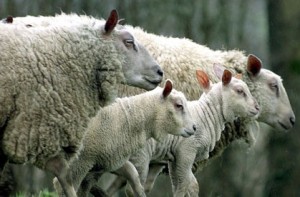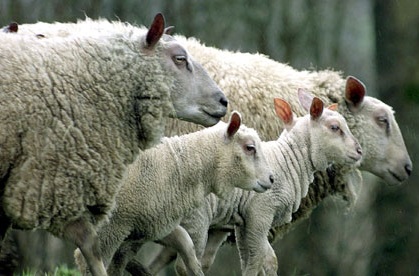Tests by the Animal Health and the Veterinary Laboratories Agency (AHVLA) have confirmed the presence of Schmallenberg virus (SBV) in livestock samples submitted since January 2012 from a number of farms in the south and east of England.
 |
| [relatedPosts title=”Related Posts”] |
|
|
Positive cases have been identified on the Isle of Wight, West Berkshire, South Gloucestershire and Wiltshire. Previously, cases have been identified across the counties of Norfolk, Suffolk, Essex, Kent, East and West Sussex, Hertfordshire, Surrey, Hampshire, Cornwall and Wiltshire.
To date, the majority of the cases of SBV infection have been in sheep with some cases reported in cattle.
SBV is a recently discovered virus, belonging in the Bunyaviridae family. It was associated with a brief mild to moderate disease in adult cattle in the Netherlands, and Germany in late August 2011. SBV infection caused fever, reduced milk yield and occasionally diarrhoea in these animals. More recently the disease has been associated with stillbirth or birth defects, mainly in sheep in Germany, the Netherlands, Belgium and France. It is thought that livestock were most probably infected by midges blown across from the English Channel from Northern Europe.
As well as areas where cases have already been identified, due to increased reports of SBV identified in France and existing modeling data, the AHVLA has revised its assessment of areas in the UK that are considered to be at higher risk of SBV. These areas now include Dorset, Devon, Somerset, and an increase in risk for South Wales.
Dr Dilys Morgan, an expert in emerging infections at the Health Protection Agency (HPA), said: “Currently, there is no evidence that Schmallenberg virus causes illness in humans and so far, no unusual illness has been reported in those who have been occupationally exposed. Although human infection cannot yet be excluded, recent risk assessments conducted by public health authorities in the Netherlands and by the European Centre for Disease Prevention and Control (ECDC) concluded that despite some current uncertainties, the risk to human health from SBV is likely to be very low.
“Nonetheless, any possibility of exposure is taken very seriously. The Department for Environment, Food and Rural Affairs (Defra) has advised farmers and veterinary surgeons to take sensible hygiene precautions when working with livestock and to report any suspicious cases to AHVLA for testing. It is also reinforcing its advice to pregnant women to avoid close contact with animals (including sheep, cows and goats) that are giving birth.
“The HPA will continue to work closely with veterinary and European public health agencies to better understand this new animal virus and any possible impact it may have on human health.”
The HPA has been working closely with colleagues at the AHVLA and has developed an information leaflet explaining what SBV is for those who may have been exposed to affected animals such as farm workers, farmers and vets. As a precautionary measure, the HPA is advising anyone who develops a fever within two weeks of contact with affected animals (such as farmers, farm workers and vets) to get in touch with their local Health Protection Unit for advice as part of the HPA’s enhanced surveillance.
Further Information.
About Schmallenberg virus (SBV)
A novel virus associated with disease in animals and provisionally named Schmallenberg virus (SBV) was identified by the Friedrich-Loeffler Institute (Germany) in late 2011. This followed the investigation of symptoms observed in dairy cows during the summer of 2011 which had included fever, poor general condition, anorexia and reduced milk yield (by up to 50%). Similar outbreaks of disease were reported from the Netherlands, where cases also had severe diarrhoea. In both countries, symptoms disappeared after a few days and the animals appeared to recover unaffected. However, in early December, a high number of congenital malformations such as twisted neck, abnormal curvature of the spine, and limb contractures occurred in newborn lambs. Many were stillborn. Similarly malformed lambs were reported in Germany, Belgium and France. The first cases in the UK were reported in January 2012.
Virology
During the summer outbreaks, affected animals were sampled but all routine microbiological investigations proved negative. However, further advanced techniques revealed novel genetic sequences in the samples, and the same sequences were then detected in tissues from the stillborn and deformed newborn animals. The sequences were subsequently shown to be the novel virus, Schmallenberg virus. Preliminary characterisation places SBV in the Bunyaviridae family, Orthobunyavirus genus, Simbu serogroup. Within this group, genetic characterisation has shown that SBV is closest to several viruses known to be pathogens in ruminants.
Transmission
Most members of the Bunyaviridae family are transmitted through arthropod vectors such as mosquitoes, midges, ticks or sand flies. It seems likely that the virus is transmitted via Culicoides midges, although no positive vectors have yet been found.
UK situation
Modelling by the Met Office suggested that midges could have arrived from the continent with the consequent possibility of disease introduction into counties of East and Southeast England. These areas were termed to be ‘at risk’. Measures instituted in Great Britain to detect the occurrence of suspect cases included informing farmers and farm vets and encouraging them to submit affected animals for investigation. Since 23 January 2012, the Animal Health Veterinary Laboratories Agency (AHVLA) has reported that SBV has been detected in congenitally deformed lambs on farms in Norfolk, Suffolk, Essex, Sussex, Kent and Hertfordshire.
Human disease
While some orthobunyavirus cause human disease, including some in the Simbu serogroup, the genetically most closely related viruses do not cause disease in humans. It is therefore considered unlikely that Schmallenberg virus is zoonotic but human infection cannot yet be excluded. No unusual human illness has been reported thus far in association with exposure to affected animals.
Future workThere are still many uncertainties around this new virus, such as the vector responsible for transmission, the geographic distribution, transmissibility of infected animals, the virus origin and its zoonotic potential.
Future work
There are still many uncertainties around this new virus, such as the vector responsible for transmission, the geographic distribution, transmissibility of infected animals, the virus origin and its zoonotic potential.
.





